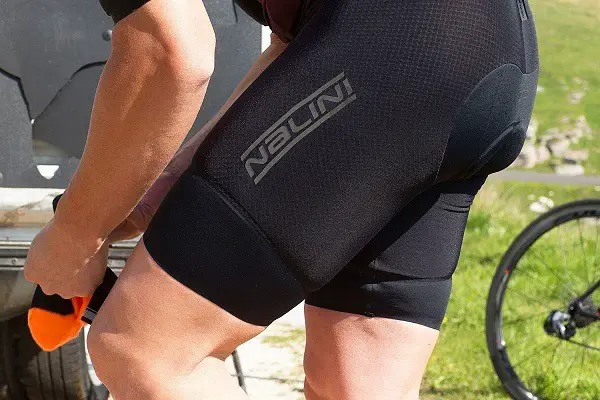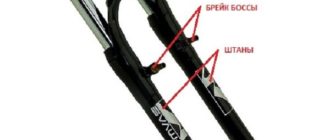In the spring of 2002, news exploded in the media space. On the slope of the Cerro Negro volcano in Nicaragua there was an accident. Eric Baron, a multiple world champion, accelerated to a speed of 210.4 km/h and collapsed. Two seconds before the crash the judges fixed a new world record, but the French extremist was already flying down the gravel slope with the remains of the bike. If not for the strong helmet and the cyclist’s equipment, the legendary “Red Rider” would have hardly got rid of rib fractures and bruises.
Why do you need bicycle gear?
Riding a bicycle – a fascinating but dangerous activity. Regardless of the experience of the rider, the vehicle does not provide absolute safety. A fall at speed without equipment, even a trained athlete can lead to serious injuries. Wet and uneven trails, gravel tosses, changes in road lighting, inattentive drivers and a hundred other factors are potential hazards to safe riding. If a cyclist’s body parts are unprotected, fractures and dislocated fractures are guaranteed.
But there are ways to significantly reduce the risk. This is cycling equipment that performs special functions:
- Clothing made of elastic fabrics provides the cyclist with maximum freedom of movement with bent knees;
- Good ventilation cools the body during high exertion;
- snug fitting clothing (jersey, shorts) reduces fatigue and prevents damage from external influences;
- the right fabric absorbs and evaporates moisture well;
- special elements built into the cyclist’s equipment enhance aerodynamics;
- protective plates protect the spine and ribs from fractures.
Comfortable clothing, shoes, and a reliable helmet are not only necessary equipment for high performance. For the average cyclist – it is the maximum comfort when riding and safety in case of falls or collisions.
Helmet
It is a mistake to think that only professional or extreme athletes need a helmet as an equipment item. A severe head injury can change a cyclist’s life forever, and not for the better. Hemorrhagic contusions to the brain resulting from a fall increase the risk of complications and lead to blood clots. But a helmet can crack and will not always protect the cyclist’s brain from hitting the inside of the skull. Therefore, it is important to buy a helmet that is reliable and of good quality, depending on your riding style.
| Type of bicycle helmet | Features of the piece of equipment |
|---|---|
| Cross Country | Low weight Ability to adjust size to fit rider’s head |
| Road and Touring | Large openings for ventilation No visor Considered a lightweight cycling outfit |
| Streamlined | Elongated shape Adjustment system The equipment is designed for high-speed rides |
| Wok | Made of sturdy material No adjustment, fits precisely to head size Used for trick disciplines and aggressive riding |
| Fullface | Protects not only the head but also the jaw of the rider Because of the risk of injury upon impact to the neck, the part the biker’s neck, it is available with additional elements Provides protection in extreme sports |
| Model with straps | No protruding parts inside the helmet No part of the equipment slips when falling Reduces strain on the head as it is worn at right angles Helps adjust the size |
| Cheap options | Not certified Half the weight of expensive helmets Less reliable equipment because it splits easily |
Gloves
Cyclist equipment includes a mandatory element that protects the hands and fingers from damage. These are cycling gloves of various modifications with the following functions:
- Reduce pressure on the hands.
- Suppress vibration.
- Protect skin from shock, sun, weather.
- Protect from blisters, rubbing against grips and steering grips.
- Provides a firm grip on the handlebars and good ventilation.
- This outfit is made of elastic fabric with water-repellent properties.
- Sewn-in plates on the back of the palm and plastic shields on the finger joints protect against mechanical damage if you fall.
- Gloves with rubber or silicone coating are comfortable for braking.
Irreplaceable attribute of cycling equipment provides a comfortable and safe ride. When choosing gloves, consider seasonal features. Comfortable cycling gloves with short fingers, made of lightweight materials are used for summer rides. With long – in autumn and winter. For the working surface use a leather or suede substitutes. Winter products are sewn from durable materials, taking into account the specifics of cycling. If you use a warm product, the sweaty hands of the cyclist will be constantly freezing. Therefore make the top of a combination of layers of fabrics: waterproof and windproof – on top, soft lining – inside. Athletes of extreme disciplines wear closed gloves that fully protect the hands and fingers. For fixation on the hand put a strap with “velcro”.
Gripsaws
Elements of cyclist’s equipment not only protect, but also save from many troubles. When the temperature approaches -20 ° C, athletes extreme disciplines wear gripsovitsy (or poggi). Made of thick material, the grip gloves are installed on different types of handlebars. For example, with horns on the edges (or in the middle) and gripshifts; without horns with dual controls. In all cases, it is convenient to shift gears and press the brake handle. The cyclist warms up the inside of the mittens in a short amount of time, creating a microclimate. Thanks to the membrane fabric formed condensate freely goes out.
Additional advantages of the equipment:
- the hand is pulled out without difficulty, because the grips are very soft;
- ventilation flap installed;
- retroreflective stripe;
- fasteners for backpack or other objects;
- thin glove is acceptable.
Rider in strong mittens is not afraid of wind, frost, rain, scratching at speed branches.
Wrist protection
When falling over the handlebars, the cyclist instinctively extends his arms to soften the blow. The wrists, where the delicate bones of the forearm and joints are located, are the first to be injured. Unadapted to the increased load of the body should be protected by special equipment. All the more so that while skiing the angle of the hand is constantly changing and causes stretching the ligaments. Special gloves are not available in stores, but sells fixing plates. There are hinges on the details of equipment, with the help of which the hand is fixed in a comfortable position. The protection is put on the glove to avoid skin chafing.
Elbow pads
Many cyclists are skeptical about this important element of cycling equipment. This indifference to elbow pads is due to people underestimating the effects of ulnar nerve injuries. Steven Barrer, MD, explains: An injured arm restricts movement, stops muscle innervation and leads to atrophy. The neurosurgeon considers the bicycle paraphernalia part of a biker’s essential equipment. Reliable protection for athletes of extreme disciplines in importance is equal to a helmet.
Collar
Extreme speed disciplines are characterized by increased risk and injury. To protect against hitting the head into a tree, in which the neck is the first to suffer, a collar was included in the protective equipment of the athlete. This piece of equipment was borrowed from motocross and helped to reduce the death rate significantly. Thanks to the locking device, the neck is not everted upon impact. Professionals recommend using the collar together with a full face helmet. Disciplines that require free body control and do not involve increased speed do not use the collar.
Shorts
Tight-fitting elastic garments follow the curves of your hips and make it easier for your pelvic muscles and joints to work. Cycling shorts are worn during the warm season. Long, tight models are used in autumn together with thermal underwear. Detachable parts help adjust the length and ventilation pockets help regulate the body temperature. For professional athletes produce shorts with a printed insert (“pampers”). Special sealing facilitates striking the saddle and friction, and well drains the moisture. Protective clothing prevents bruises on the coccyx when falling and injuries to the muscle bundles of the buttocks, which is the main extensor of the hips. These models are popular with speed electric bikers.
Knee pads .
Designers went to a lot of trouble to create a knee protection harness. Good knee pads must protect the main joint between the femur, tibia and patella from injury. A branded piece of equipment costs 70-100 dollars, but the treatment of the knee by doctors is ten times more. Therefore, athletes of extreme disciplines do not go out without protective equipment. Knee pads are available as a separate item or sewn into the cycling pants. The choice of equipment depends on the purpose of protection: only the knee, shin, knee joint with shin. Troy Lee Designs products are considered the best pieces of cyclist equipment for quality to price ratio.
Ankle and ankle protection
Ankle injuries and sprains account for 40% of all sports injuries. Even foot sprains cause complications. Doctors note that re-injury of the ankle and ankle within 3 years accounts for 73% of cases in cyclists. It is difficult to fully recover from a serious injury. An item of cycling equipment is usually purchased not to protect the ankle, but to be able to fix the injured joints. Nylon, polyurethane foam, and plastic are used to make the product. Lacing helps to fit the piece to the foot. But the cyclist can also suffer from the bite of dogs, the clamping of their jaws is two to three hundred kilograms.
Protection from cars from behind
Equipment for the cyclist is not only a way to avoid complications from injuries and protect yourself from the weather conditions. The biker uses special equipment so that the cars coming from behind can see the road user. To do this, the clothing, shoes, backpacks sew on the plates with LEDs. Protective equipment includes simple and cheap highly specialized headlights. The source of light is well perceived by the eyes of drivers. A light output of 600-1200 lumens is suitable for the average cyclist. Advertising agencies often present backpacks, buffs, technical equipment as protective gear, which is not the cyclist’s equipment.
Mask and goggles.
Dust, rain, insects, and rocks get the cyclist in trouble. The abrupt transition from bright sunlight to shade causes a momentary blackout in the eyes. It takes time for pupils to dilate and adjust to less light. When riding at speed, the cyclist may not see an obstacle and may crash into it. Additional eye protection with plastic lenses is included for safety. Goggles are used in conjunction with Cross-country—what-it-is–nuances helmets. Masks – with fullfaces and bowlers.
Quality requirements:
- Transparent (not tinted) lenses made of polycarbonate. They are 16 times lighter than glass and 200% stronger.
- Special UV protection and fogging.
- Soft and durable ear pads.
- Moulded nosepads and adjustable ear pads.
- Polarized lenses should not let in reflected light.
For sport riding, goggles and mask are covered with a special coating, which increases the clarity, brightness, contrast of the view.
Conclusion
There is no universal set for all disciplines of cycling. But the importance of competent equipment is understood by athletes and manufacturers alike. Each detail is designed and tested together with professionals. The link between bike and rider is not only a safety feature, but also a lifesaver.











